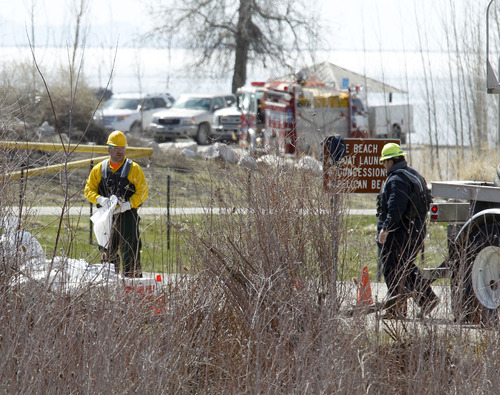This is an archived article that was published on sltrib.com in 2013, and information in the article may be outdated. It is provided only for personal research purposes and may not be reprinted.
There's no sign so far of acute impacts around Willard Bay State Park from the Chevron Pipe Line Co. diesel spill, a state official said Wednesday.
"We don't have an immediate human health or ecological issue at this point," said John Whitehead, assistant director of the Utah Division of Water Quality and leader of the state's response to the spill.
But there are traces of petrochemicals beginning to show up in water tests, he said. "We expected to see it. There's no way you're going to dump 20,000 gallons of diesel on the ground and not see a little dissolved product get through the system."
Whitehead gave an update on the cleanup under way for eight days at Willard Bay State Park, just south of the Bear River Migratory Bird Refuge, where as much as 27,500 gallons of diesel fuel spilled from a Salt Lake City-to-Spokane pipeline last week.
The U.S. Environmental Protection Agency has led a multi-agency emergency response team that it focused on removing as much oil from the surrounding wetlands before the bird migration season goes into full swing.
About 100 cleanup workers have laid ribbons of absorbent boom throughout the area and skimmed the petroleum from the water's surface. About 14,000 gallons have been recovered so far.
Investigators from the U.S. Transportation Department's Pipeline and Hazardous Materials Safety Administration have made a preliminary determination that a split in the lengthwise seam of the pipe is responsible for the spill. Diesel from five Salt Lake City refineries travels 760 miles though the line.
Whitehead showed board members a photo of the split, a 74-inch-long gash in the 8-inch pipe beneath a thick corrosion-resistant coating.
"That failure poses a bigger issue beyond this board, and that is the infrastructure of the pipeline," Whitehead said, noting the steel conduit is more than 60 years old. "It was chilling to me to see this pipe is 3 feet away from a gasoline pipeline."
On Friday, the Pipeline and Hazardous Materials Safety Administration ordered the Texas-based company not to restart the pipeline until federal authorities approve the fixes — and then only at 80 percent of normal pressure and under "continuous patrolling" of a 3-mile segment of the pipeline.
"This Corrective Action Order," said the agency directive, "is being issued under [federal law] to require Chevron Pipe Line Co. (Chevron or Respondent) to take the necessary corrective action to protect the public, property and the environment from potential hazards associated with the recent failure on Chevron's #1 Oil line in Willard, Utah."
The state has 11 monitoring sites, and four of 27 samples have shown traces of petrochemicals in the freshwater Willard Reservoir so far. But its still too early to make any final conclusions, Whitehead said.
Six beavers — including an adult and two juveniles found just Tuesday — have been rescued from the site, and at least one dead fish has been discovered. The state park has been closed since March 18, the day Chevron discovered and reported the leak.
Twitter: @judyfutah —
Beavers saved the day
The tangle of beaver dams and marsh vegetation at Willard Bay state park played a crucial role in protecting the Willard Bay area from more significant damage, a state official said Wednesday. John Whitehead, deputy director of the Utah Division of Water Quality, said the area's famed "hero beavers" that everyone's hearing about really did prevent disaster.
"If we didn't have a wetland complex in there that slowed the flow" of spilled diesel, he said, that stuff would have poured into Willard Bay within an hour."
Six beavers from the spill area are recuperating at a Wildlife Rehabilitation Center of Northern Utah in Ogden.



